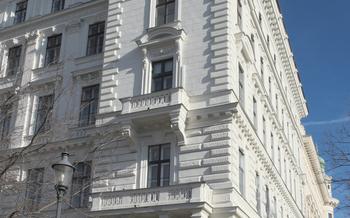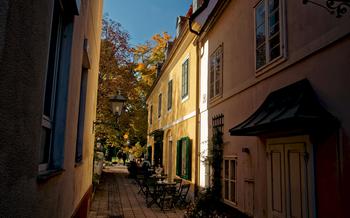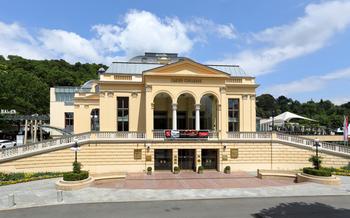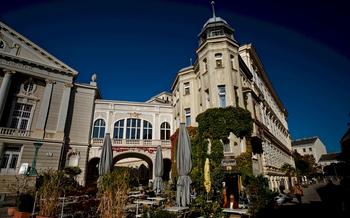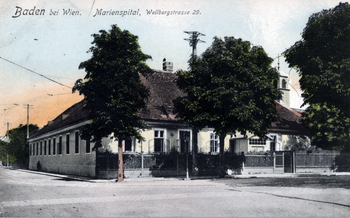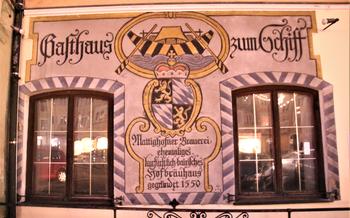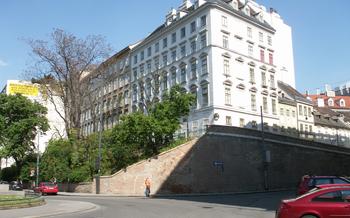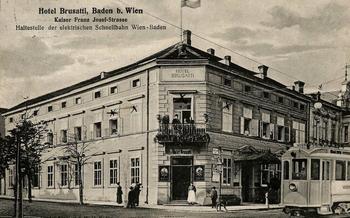
Beethoven Museum Heiligenstadt
- Beethoven Museum Heiligenstadt: A Journey into the Master's Creative Haven
- Stepping into Beethoven's World: An Interactive Experience
- Exploring the Heiligenstadt Testament: A Window into Beethoven's Inner Turmoil
- The Heiligenstadt Period: A Time of Transformation
- The Surrounding Area: A Picturesque Haven
- The Beethoven Trail: Following in the Master's Footsteps
- Musical Performances and Events: Experiencing Beethoven's Legacy
- Beethoven's Impact on Vienna: A Cultural Legacy
- Accommodation and Dining Options: Catering to Every Taste
- Transportation and Accessibility: Getting There and Around
- Planning Your Visit: Making the Most of Your Time
- Educational Programs and Workshops: Engaging with Beethoven's Music
- Souvenirs and Merchandise: Taking a Piece of Beethoven Home
- Insider Tip: Discovering Hidden Gems
Beethoven Museum Heiligenstadt: A Journey into the Master's Creative Haven
Nestled in the picturesque town of Heiligenstadt, just outside Vienna, the Beethoven Museum Heiligenstadt invites visitors on a captivating journey into the life and work of the legendary composer Ludwig van Beethoven. Occupying the very house where Beethoven composed some of his most iconic masterpieces, including the "Moonlight Sonata," the museum offers a unique glimpse into the creative process of one of the greatest musical geniuses of all time.
Located at Probusgasse 6, the museum is easily accessible by public transport, with the Heiligenstadt S-Bahn station just a short walk away. Visitors can delve into Beethoven's world from Tuesday to Sunday, with guided tours available in English and German at specific times throughout the day. Admission fees vary depending on the type of ticket, with discounts for students, seniors, and families. Audio guides are also available for rent, providing a self-guided tour experience in multiple languages.
Stepping into Beethoven's World: An Interactive Experience
The Beethoven Museum Heiligenstadt is not just a repository of historical artifacts; it is an immersive experience that transports visitors into the world of the great composer. Through interactive exhibits, multimedia presentations, and personal memorabilia, the museum offers a multisensory journey into Beethoven's life and work.
Visitors can explore interactive displays that allow them to engage with Beethoven's music in a hands-on way. They can listen to his compositions, conduct a virtual orchestra, and even compose their own melodies using Beethoven's motifs. Multimedia presentations provide insights into his creative process, his struggles with deafness, and his enduring impact on the world of music.
Personal artifacts and memorabilia offer a glimpse into Beethoven's life beyond the music. Visitors can see the piano on which he composed some of his most famous works, the hearing aid he used to cope with his deafness, and the Heiligenstadt Testament, a deeply personal document in which he poured out his feelings of despair and isolation. These artifacts bring Beethoven the man to life, allowing visitors to connect with him on a deeper level.
Exploring the Heiligenstadt Testament: A Window into Beethoven's Inner Turmoil
In 1802, Ludwig van Beethoven penned a deeply personal document known as the Heiligenstadt Testament. This poignant letter, addressed to his brothers, reveals the profound emotional turmoil he was experiencing at the time. Beethoven, who had been struggling with increasing deafness, poured out his frustrations, fears, and hopes in this intimate confession.
In the testament, Beethoven laments the isolation and despair he felt as his hearing deteriorated. He writes, "O you men who think or say that I am misanthropic, how greatly do you wrong me. You do not know the secret cause which makes me seem that way to you." He expresses his longing for a "cure" for his deafness, but also acknowledges the futility of such hope.
Despite his despair, Beethoven's resilience and determination shine through in the Heiligenstadt Testament. He resolves to continue composing, even if he can no longer hear his own music. He writes, "I will seize fate by the throat; it shall not wholly overcome me. Oh, it is so beautiful to live—to live a thousand times."
The Heiligenstadt Testament is a powerful testament to Beethoven's inner strength and his unwavering commitment to his art. It offers visitors to the Beethoven Museum Heiligenstadt a unique glimpse into the composer's soul, revealing the depths of his suffering and his indomitable spirit.
Interactive Displays
The Beethoven Museum Heiligenstadt features interactive displays that allow visitors to learn more about the Heiligenstadt Testament and its significance. Visitors can read transcriptions of the testament, listen to audio recordings of it being read aloud, and explore interactive timelines that trace Beethoven's life and work during this tumultuous period.
These interactive displays provide a deeper understanding of Beethoven's struggles with deafness and isolation, and how they shaped his music and his life. They also highlight the enduring power of the Heiligenstadt Testament as a symbol of Beethoven's resilience and determination in the face of adversity.
The Heiligenstadt Period: A Time of Transformation
During his stay in Heiligenstadt, Beethoven experienced a period of both personal and creative transformation. Deafness, which had been gradually affecting him for several years, became increasingly severe, leading to a profound sense of isolation and despair. This inner turmoil is reflected in the Heiligenstadt Testament, a deeply personal document written in 1802, in which Beethoven poured out his feelings of hopelessness and contemplated suicide.
Despite his struggles with deafness, Beethoven's creative output during this period was remarkable. He composed some of his most famous works, including the "Moonlight Sonata," the "Heiligenstadt Testament" String Quartet, and the Third Symphony ("Eroica"). These works showcased his innovative use of form and harmony, pushing the boundaries of classical music and paving the way for the Romantic era.
The Heiligenstadt period was a time of both darkness and light for Beethoven. He confronted his own mortality and the limitations imposed by his deafness, but he also found solace and inspiration in his music. Through his compositions, he transcended his personal struggles and created works of lasting beauty and significance.
The Surrounding Area: A Picturesque Haven
Nestled amidst the rolling hills of Vienna Woods, Heiligenstadt offers breathtaking natural beauty that complements the rich musical history of the area. The idyllic landscape invites visitors to explore its scenic surroundings and immerse themselves in the tranquility that inspired Beethoven's compositions.
For those seeking outdoor adventures, Heiligenstadt serves as a gateway to a network of hiking trails that wind through lush forests and offer panoramic views of the surrounding countryside. Whether you prefer a leisurely stroll or a challenging trek, there's a trail to suit every fitness level.
Cyclists can embark on a leisurely ride along the Danube River, enjoying the picturesque views of the riverbanks and the vineyards that dot the landscape. Boats and kayaks are also available for rent, allowing visitors to explore the serene waters of the Old Danube and discover hidden coves and inlets.
Heiligenstadt is surrounded by charming villages and historical sites that are worth exploring. A short walk or bike ride takes you to the picturesque village of Grinzing, known for its traditional wine taverns and Heurigen, where you can sample local wines and Austrian delicacies. The nearby Kahlenberg hill offers stunning views of Vienna and the surrounding countryside, making it a popular destination for hikers and nature enthusiasts.
To fully immerse yourself in the natural beauty of Heiligenstadt, consider packing a picnic lunch and finding a secluded spot along the riverbank or in the forest. Let the sounds of nature and the melodies of Beethoven's music transport you to a state of tranquility and inspiration.
The Beethoven Trail: Following in the Master's Footsteps
The Beethoven Trail is a captivating walking path that connects Heiligenstadt to Vienna, offering a unique opportunity to retrace the footsteps of the legendary composer. This scenic trail winds through picturesque landscapes, historical landmarks, and sites closely associated with Beethoven's life.
Along the trail, visitors can explore key locations that played a significant role in Beethoven's creative journey. These include the Pfarrkirche Heiligenstadt, where Beethoven famously premiered his Mass in C major, Op. 86, and the Gasthof zur Rose, where he resided during his Heiligenstadt period.
The trail is dotted with informative panels that provide insights into Beethoven's life and work, as well as historical anecdotes and stories related to his time in the area. These panels bring Beethoven's presence to life, allowing visitors to connect with his spirit and gain a deeper understanding of his creative process.
Whether you're an avid hiker, a music enthusiast, or simply seeking a unique travel experience, the Beethoven Trail promises an immersive journey into the life and legacy of one of the greatest composers of all time.
Musical Performances and Events: Experiencing Beethoven's Legacy
The Beethoven Museum Heiligenstadt not only offers a glimpse into the composer's life and work but also provides opportunities to experience his music firsthand. Regular concerts and musical events are held at the museum, featuring performances by renowned musicians and ensembles. These events range from intimate recitals to grand orchestral concerts, showcasing Beethoven's works in their full glory.
Visitors can immerse themselves in the sounds of Beethoven's compositions, performed in the very place where he found inspiration and composed some of his most iconic works. The acoustics of the museum's concert hall are designed to create an optimal listening experience, allowing audiences to fully appreciate the nuances and subtleties of Beethoven's music.
In addition to concerts, the museum also hosts special exhibitions and events commemorating Beethoven's life and achievements. These events often feature rare artifacts, manuscripts, and personal belongings of the composer, offering visitors a deeper understanding of his creative process and personal journey.
To ensure a memorable and enriching experience, it is recommended to check the museum's website or contact them directly for information on upcoming concerts, events, and ticket availability. Advance booking is advisable, especially for popular events, to avoid disappointment and secure the best seats.
Beethoven's Impact on Vienna: A Cultural Legacy
Ludwig van Beethoven's influence on Vienna's cultural landscape cannot be overstated. His presence in the city left an indelible mark, shaping its musical identity and elevating it to the status of a global music capital.
Beethoven's music and innovations challenged conventions and pushed the boundaries of classical music. His compositions, characterized by their emotional depth, technical brilliance, and groundbreaking structures, captivated audiences and revolutionized the genre.
Beyond his musical contributions, Beethoven's charisma and personality left a lasting impression on Vienna's cultural scene. His concerts drew throngs of admirers, eager to witness his performances and experience the magic of his music firsthand.
As a result of Beethoven's influence, Vienna became a magnet for musicians, composers, and music lovers from around the world. The city's reputation as a hub of musical excellence attracted talented individuals seeking inspiration and opportunities to collaborate with some of the greatest minds in the field.
To this day, Vienna proudly celebrates its association with Beethoven. Numerous landmarks and monuments bear his name, paying homage to his legacy. The Vienna State Opera, Musikverein, and Konzerthaus regularly feature performances of his works, ensuring that his music continues to resonate within the city's cultural tapestry.
If you delve into Vienna's musical history, you'll find countless threads that lead back to Beethoven. His influence permeates the city's concert halls, opera houses, and music schools, shaping the vibrant musical landscape that Vienna is renowned for.
Accommodation and Dining Options: Catering to Every Taste
Heiligenstadt offers a range of accommodation options to suit every budget and preference. From cozy guesthouses nestled amidst the vineyards to modern hotels with stunning views of the Danube River, there's something for every traveler. For a truly immersive experience, consider staying at the Beethovenhaus, a charming guesthouse located in the heart of the village, just steps away from the Beethoven Museum.
When it comes to dining, Heiligenstadt's culinary scene is as diverse as its accommodation options. From traditional Austrian taverns serving hearty dishes like Wiener Schnitzel and Tafelspitz to international restaurants offering a taste of flavors from around the world, there's something to satisfy every palate. Be sure to sample local specialties such as Viennese coffee, Sachertorte, and Apfelstrudel, all of which can be found at the many cafés and bakeries in the area.
For those on a budget, there are several affordable options available. Many guesthouses and hotels offer breakfast included in the room rate, and there are also several supermarkets and grocery stores where you can stock up on picnic supplies. Self-catering apartments are another great option for budget-conscious travelers, as they allow you to prepare your own meals.
To make the most of your dining experience, be sure to book reservations in advance, especially for popular restaurants during peak season. And don't forget to ask for recommendations from the locals – they'll be happy to point you in the direction of their favorite hidden gems.
Transportation and Accessibility: Getting There and Around
Reaching the Beethoven Museum by Public Transport:
-
Take the U4 subway line to Heiligenstadt station, which is just a short walk from the museum.
-
Alternatively, you can take bus lines 38A or 40A and get off at the Heiligenstadt stop.
-
For a more scenic journey, consider taking the Vienna tram line D and getting off at the Heiligenstadtbrücke stop, which offers stunning views of the Danube River.
Parking Options for Those Traveling by Car:
-
There is limited street parking available in the vicinity of the Beethoven Museum.
-
For guaranteed parking, consider using one of the nearby public parking garages, such as the Heiligenstadtgarage or the Donauzentrum garage.
Accessibility Information for Visitors with Disabilities:
-
The Beethoven Museum is wheelchair accessible, with ramps and elevators providing access to all floors.
-
Assisted listening devices and wheelchairs are available upon request at the museum's information desk.
-
Visitors with disabilities are entitled to a reduced admission fee.
Tips for Navigating the Area and Getting Around Heiligenstadt:
-
Heiligenstadt is a relatively small and walkable neighborhood, making it easy to explore on foot.
-
For longer distances, consider renting a bicycle from one of the many bike rental shops in the area.
-
You can also take a taxi or use ride-sharing services to get around Heiligenstadt and Vienna.
Planning Your Visit: Making the Most of Your Time
To fully immerse yourself in Beethoven's world at the Beethoven Museum Heiligenstadt, plan to spend at least two to three hours exploring the exhibits, listening to the interactive displays, and engaging with the multimedia presentations. If you're particularly interested in the Heiligenstadt Testament, allow for additional time to delve deeper into its significance and impact on Beethoven's life.
To avoid crowds and ensure a more personalized experience, consider visiting the museum during the off-season (November to March) or on weekdays. This will give you the opportunity toじっくりと explore the exhibits without feeling rushed or overwhelmed.
For the best weather and fewer tourists, aim to visit Heiligenstadt during the shoulder seasons (April-May and September-October). The picturesque surroundings come alive with vibrant colors and offer a delightful backdrop to your visit.
Pack comfortable shoes for walking, as you'll be exploring both the museum and the surrounding area. Don't forget your camera to capture the beautiful scenery and your personal interactions with Beethoven's legacy.
Educational Programs and Workshops: Engaging with Beethoven's Music
The Beethoven Museum Heiligenstadt offers a range of educational programs and workshops designed to engage visitors of all ages with Beethoven's life and music. These programs provide an immersive and interactive learning experience, allowing participants to delve deeper into the composer's creative process and gain a greater appreciation for his work.
Children and adults alike can participate in workshops that explore various aspects of Beethoven's music. Interactive activities, such as composing melodies or playing musical instruments, help participants understand the complexities of Beethoven's compositions and the challenges he faced as a deaf composer.
Hands-on experiences, such as creating replicas of Beethoven's musical instruments or experimenting with different sound effects, provide a unique and memorable way to learn about Beethoven's creative genius.
Educational programs also include guided tours of the museum's exhibits, led by knowledgeable docents who share insights into Beethoven's life and work. These tours offer a deeper understanding of the historical context and significance of Beethoven's music.
Whether you are a seasoned music lover or simply curious to learn more about Beethoven, the educational programs and workshops at the Beethoven Museum Heiligenstadt offer a unique and engaging way to immerse yourself in the world of this musical giant.
Practical information for booking workshops and planning your educational visit is available on the museum's website. Advance reservations are recommended to ensure your spot.
Souvenirs and Merchandise: Taking a Piece of Beethoven Home
The Beethoven Museum shop is a treasure trove of souvenirs and merchandise that will delight any fan of the great composer. From traditional souvenirs like postcards and magnets to unique gifts like Beethoven-themed jewelry and clothing, there's something for everyone.
For those looking for a truly special memento, the shop offers a range of limited-edition items and collector's pieces. These include replicas of Beethoven's musical manuscripts, signed prints of his portraits, and even pieces of jewelry inspired by his music.
In addition to museum-exclusive items, the shop also carries a selection of books, CDs, and DVDs related to Beethoven. This is a great opportunity to learn more about his life and work, or to simply enjoy his music in a new way.
For those unable to visit the museum in person, there is also an online shop where you can purchase a wide range of Beethoven-related merchandise. This is a convenient option for those who live far away or who simply prefer to shop from the comfort of their own home.
Whether you're looking for a gift for a fellow Beethoven enthusiast or simply a souvenir to remind you of your visit to Heiligenstadt, the Beethoven Museum shop is sure to have something to suit your needs.
Insider Tip: Discovering Hidden Gems
Beyond the well-known attractions, Heiligenstadt holds a treasure trove of hidden gems waiting to be discovered by curious travelers. One such gem is the unsung Beethoven Monument, nestled in a quiet corner of the town. This poignant sculpture captures the essence of Beethoven's spirit, inviting visitors to reflect on his struggles and triumphs.
For those seeking a unique culinary experience, I highly recommend venturing off the beaten path to discover the local tavern, Gasthaus zum Goldenen Hirschen. This charming establishment serves traditional Austrian fare with a modern twist, offering a delightful taste of Heiligenstadt's culinary heritage.
If you're an avid hiker, embark on the lesser-known Beethoven Path, which winds through the picturesque landscapes that inspired the composer. Along the way, you'll encounter hidden viewpoints, serene meadows, and enchanting forests, making for a truly immersive experience.
Don't miss the opportunity to engage with the local community by attending one of the many traditional festivals held throughout the year. These vibrant celebrations offer a glimpse into Heiligenstadt's rich cultural heritage and provide a chance to connect with the friendly locals.
For a truly unforgettable experience, time your visit to coincide with the annual Beethoven Festival, which brings the town alive with music, performances, and exhibitions. Immerse yourself in the spirit of Beethoven as the town pays homage to its most famous resident.
